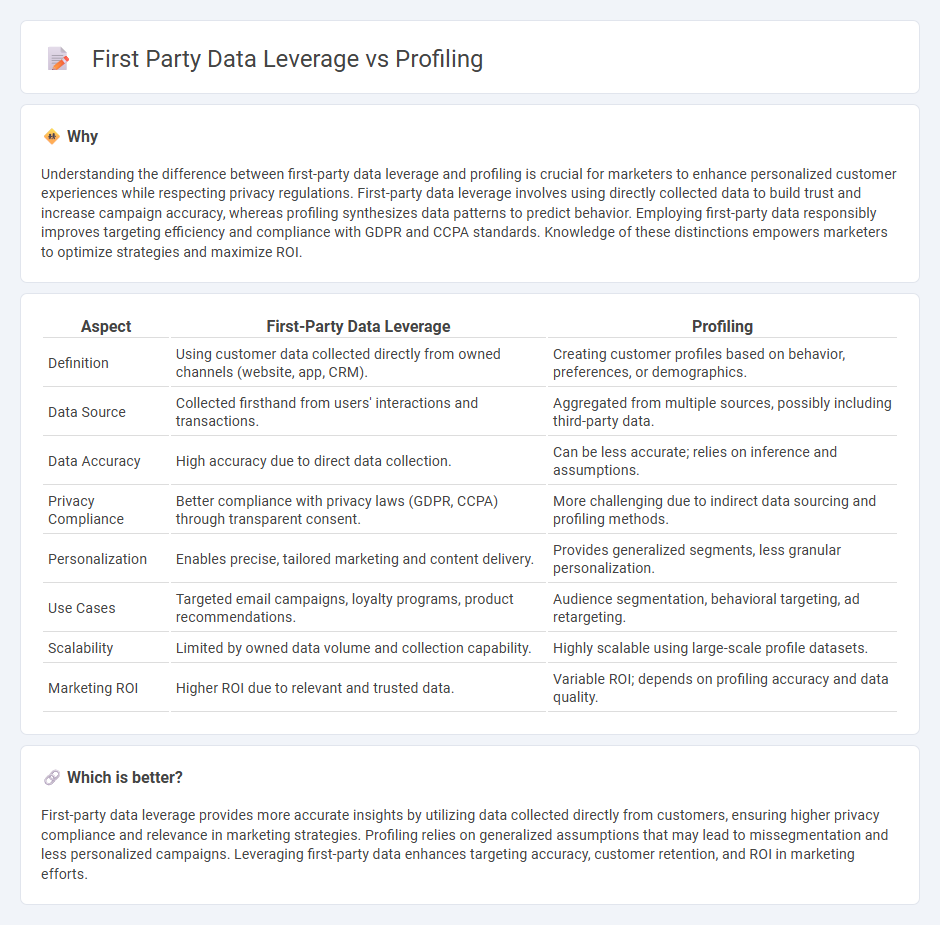
First-party data offers direct insights from customer interactions, enabling marketers to create personalized and relevant campaigns without relying on third-party sources. Leveraging this data enhances accuracy in targeting while ensuring compliance with privacy regulations, contrasting traditional profiling methods that depend on inferred or aggregated user information. Explore how maximizing first-party data can transform your marketing strategy and drive higher engagement.
Why it is important
Understanding the difference between first-party data leverage and profiling is crucial for marketers to enhance personalized customer experiences while respecting privacy regulations. First-party data leverage involves using directly collected data to build trust and increase campaign accuracy, whereas profiling synthesizes data patterns to predict behavior. Employing first-party data responsibly improves targeting efficiency and compliance with GDPR and CCPA standards. Knowledge of these distinctions empowers marketers to optimize strategies and maximize ROI.
Comparison Table
| Aspect | First-Party Data Leverage | Profiling |
|---|---|---|
| Definition | Using customer data collected directly from owned channels (website, app, CRM). | Creating customer profiles based on behavior, preferences, or demographics. |
| Data Source | Collected firsthand from users' interactions and transactions. | Aggregated from multiple sources, possibly including third-party data. |
| Data Accuracy | High accuracy due to direct data collection. | Can be less accurate; relies on inference and assumptions. |
| Privacy Compliance | Better compliance with privacy laws (GDPR, CCPA) through transparent consent. | More challenging due to indirect data sourcing and profiling methods. |
| Personalization | Enables precise, tailored marketing and content delivery. | Provides generalized segments, less granular personalization. |
| Use Cases | Targeted email campaigns, loyalty programs, product recommendations. | Audience segmentation, behavioral targeting, ad retargeting. |
| Scalability | Limited by owned data volume and collection capability. | Highly scalable using large-scale profile datasets. |
| Marketing ROI | Higher ROI due to relevant and trusted data. | Variable ROI; depends on profiling accuracy and data quality. |
Which is better?
First-party data leverage provides more accurate insights by utilizing data collected directly from customers, ensuring higher privacy compliance and relevance in marketing strategies. Profiling relies on generalized assumptions that may lead to missegmentation and less personalized campaigns. Leveraging first-party data enhances targeting accuracy, customer retention, and ROI in marketing efforts.
Connection
First-party data leverage enhances marketing precision by enabling detailed customer profiling through direct data collection from user interactions. Profiling uses this rich, consented data to segment audiences based on behaviors, preferences, and demographics, driving personalized campaigns and improved customer engagement. Effective use of first-party data ensures marketers maintain data privacy compliance while maximizing targeting accuracy and ROI.
Key Terms
Customer Segmentation
Customer segmentation benefits significantly from leveraging first-party data, as it provides accurate, privacy-compliant insights directly collected from user interactions and behaviors. Profiling enhances segmentation by synthesizing various data points, including demographic, psychographic, and transaction data, to create detailed customer personas. Explore how integrating profiling techniques with first-party data can elevate your customer segmentation strategy for personalized marketing.
Consent Management
Profiling relies on collecting and analyzing user behavior data, often necessitating explicit consent under data protection regulations like GDPR and CCPA. First-party data leverage emphasizes direct data collection from users with transparent consent management, ensuring compliance and enhancing trust. Explore how advanced consent management tools empower businesses to responsibly utilize user data while respecting privacy.
Data Enrichment
Profiling enhances customer insights by aggregating behavioral, demographic, and psychographic data, while first-party data leverage focuses on direct interactions collected from owned channels such as websites and apps. Data enrichment integrates external datasets with first-party data to provide a comprehensive, accurate, and actionable customer profile, significantly improving targeting and personalization strategies. Explore how combining profiling with enriched first-party data can revolutionize your marketing analytics and customer engagement.
Source and External Links
What is automated individual decision-making and profiling? | ICO - This resource explains profiling as a form of automated processing of personal data used to evaluate or predict aspects of a natural person's attributes, such as behavior or preferences.
Offender profiling - Wikipedia - Offender profiling is an investigative strategy used by law enforcement agencies to identify likely suspects based on behavioral patterns and crime scene analysis.
Profiling - Sentry Docs - Profiling provides code-level visibility into application execution, helping developers debug performance issues by visualizing call stacks across threads.
 dowidth.com
dowidth.com